Project Management Challenges: Boeing 787 Dreamliner Case Study
VerifiedAdded on 2020/03/13
|8
|1602
|55
Report
AI Summary
This report examines the project management of the Boeing 787 Dreamliner, a project that aimed to create a fuel-efficient airliner using composite materials. Despite its innovative features, the project faced significant problems, including weight issues, delays due to procurement and technical difficulties, over budget, and electrical system failures. The report details these challenges, emphasizing the lack of clear strategies, inadequate planning, and insufficient risk management. It provides a critical evaluation of the project management, highlighting the importance of well-defined objectives, proper planning, project priority systems, and robust risk management. The report concludes that the Boeing 787 Dreamliner project suffered due to inefficient project management strategies and proposes improvements for future projects. The report also includes references to relevant literature on project management principles.
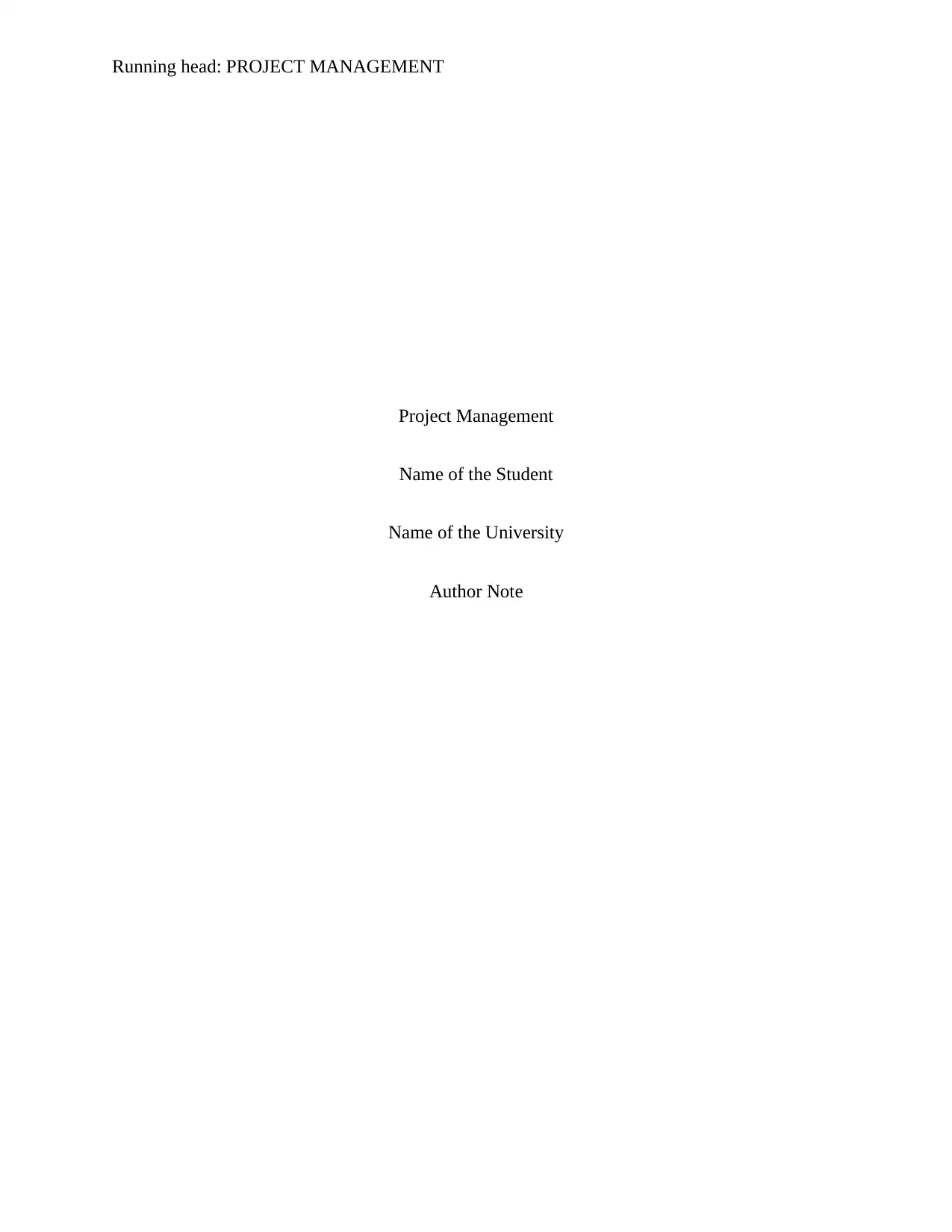
Running head: PROJECT MANAGEMENT
Project Management
Name of the Student
Name of the University
Author Note
Project Management
Name of the Student
Name of the University
Author Note
Paraphrase This Document
Need a fresh take? Get an instant paraphrase of this document with our AI Paraphraser
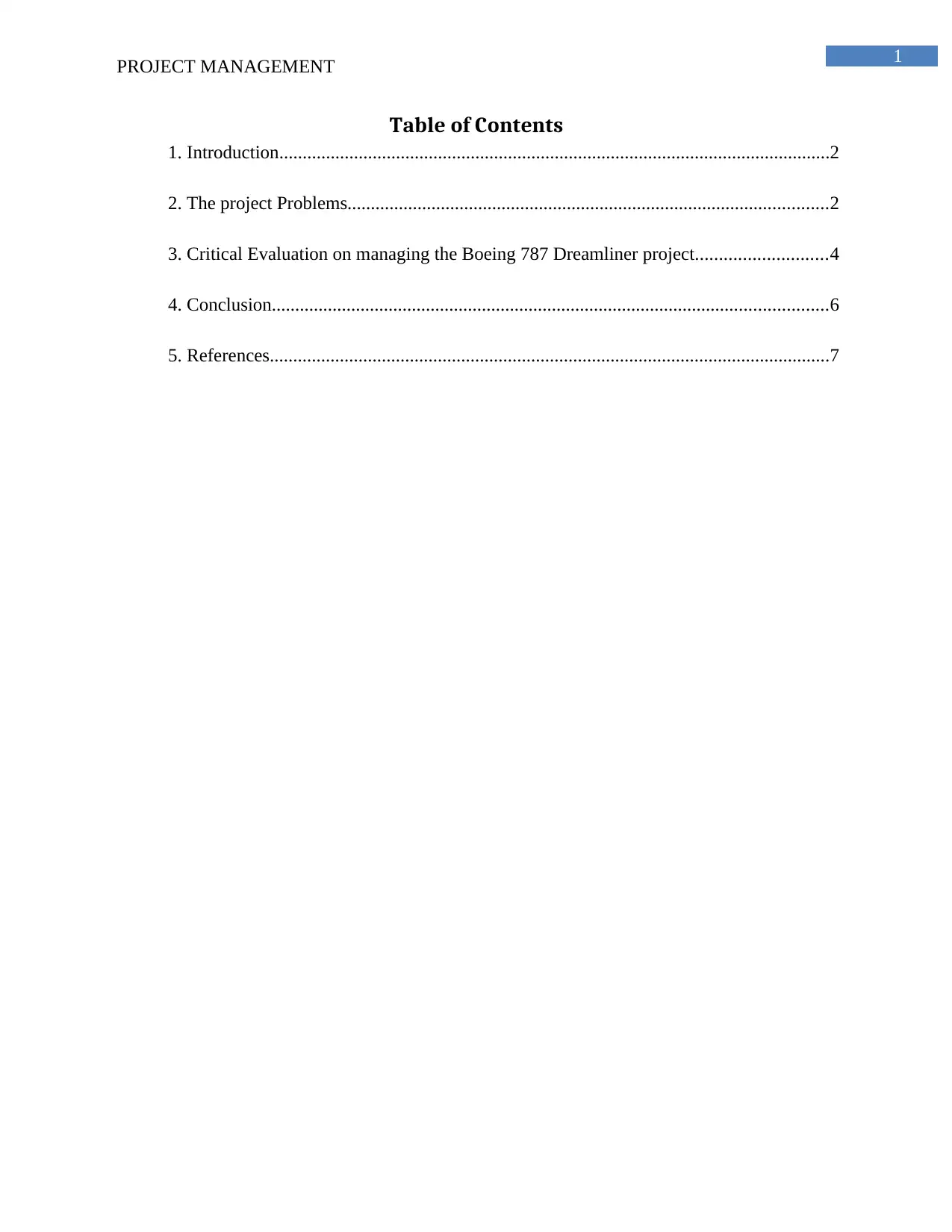
1
PROJECT MANAGEMENT
Table of Contents
1. Introduction......................................................................................................................2
2. The project Problems.......................................................................................................2
3. Critical Evaluation on managing the Boeing 787 Dreamliner project............................4
4. Conclusion.......................................................................................................................6
5. References........................................................................................................................7
PROJECT MANAGEMENT
Table of Contents
1. Introduction......................................................................................................................2
2. The project Problems.......................................................................................................2
3. Critical Evaluation on managing the Boeing 787 Dreamliner project............................4
4. Conclusion.......................................................................................................................6
5. References........................................................................................................................7
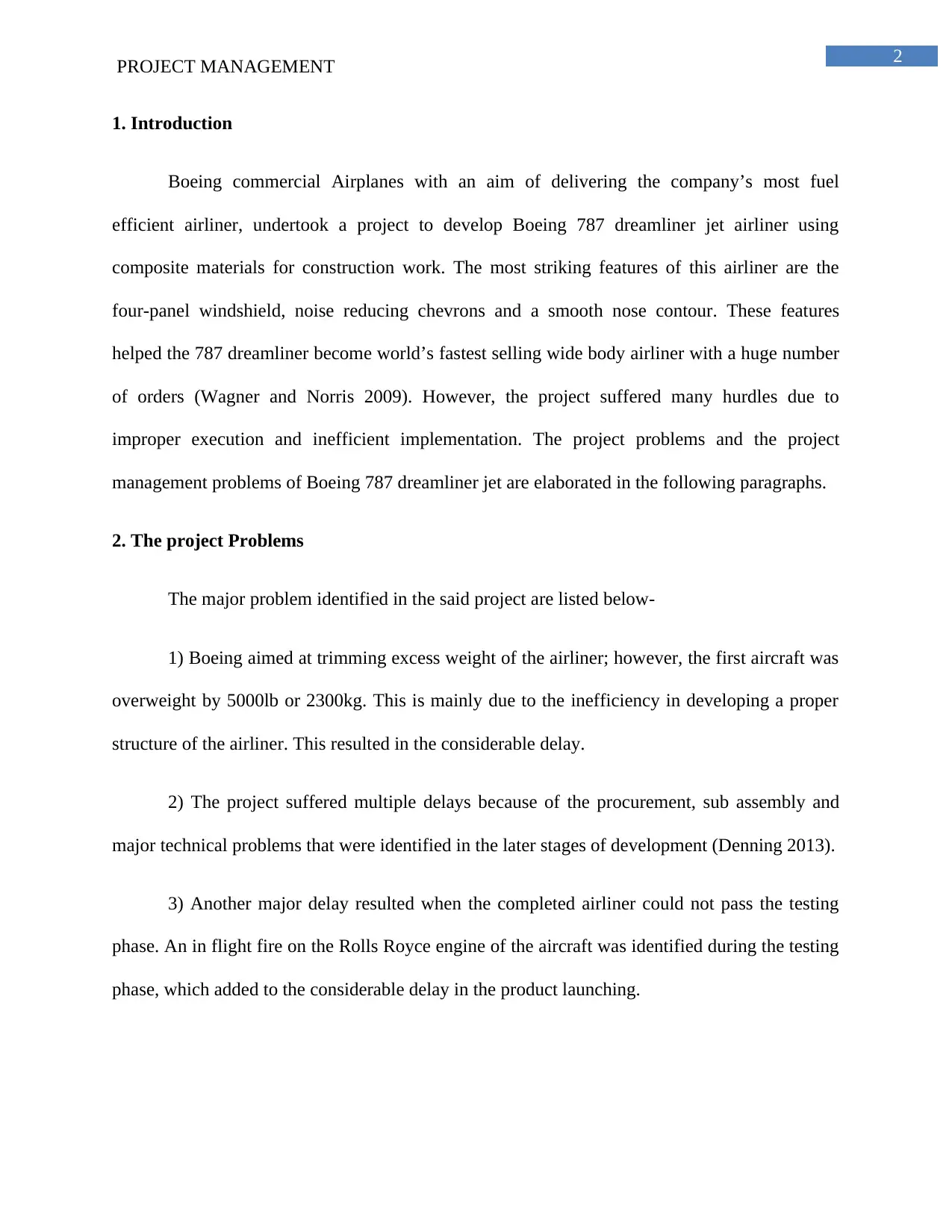
2
PROJECT MANAGEMENT
1. Introduction
Boeing commercial Airplanes with an aim of delivering the company’s most fuel
efficient airliner, undertook a project to develop Boeing 787 dreamliner jet airliner using
composite materials for construction work. The most striking features of this airliner are the
four-panel windshield, noise reducing chevrons and a smooth nose contour. These features
helped the 787 dreamliner become world’s fastest selling wide body airliner with a huge number
of orders (Wagner and Norris 2009). However, the project suffered many hurdles due to
improper execution and inefficient implementation. The project problems and the project
management problems of Boeing 787 dreamliner jet are elaborated in the following paragraphs.
2. The project Problems
The major problem identified in the said project are listed below-
1) Boeing aimed at trimming excess weight of the airliner; however, the first aircraft was
overweight by 5000lb or 2300kg. This is mainly due to the inefficiency in developing a proper
structure of the airliner. This resulted in the considerable delay.
2) The project suffered multiple delays because of the procurement, sub assembly and
major technical problems that were identified in the later stages of development (Denning 2013).
3) Another major delay resulted when the completed airliner could not pass the testing
phase. An in flight fire on the Rolls Royce engine of the aircraft was identified during the testing
phase, which added to the considerable delay in the product launching.
PROJECT MANAGEMENT
1. Introduction
Boeing commercial Airplanes with an aim of delivering the company’s most fuel
efficient airliner, undertook a project to develop Boeing 787 dreamliner jet airliner using
composite materials for construction work. The most striking features of this airliner are the
four-panel windshield, noise reducing chevrons and a smooth nose contour. These features
helped the 787 dreamliner become world’s fastest selling wide body airliner with a huge number
of orders (Wagner and Norris 2009). However, the project suffered many hurdles due to
improper execution and inefficient implementation. The project problems and the project
management problems of Boeing 787 dreamliner jet are elaborated in the following paragraphs.
2. The project Problems
The major problem identified in the said project are listed below-
1) Boeing aimed at trimming excess weight of the airliner; however, the first aircraft was
overweight by 5000lb or 2300kg. This is mainly due to the inefficiency in developing a proper
structure of the airliner. This resulted in the considerable delay.
2) The project suffered multiple delays because of the procurement, sub assembly and
major technical problems that were identified in the later stages of development (Denning 2013).
3) Another major delay resulted when the completed airliner could not pass the testing
phase. An in flight fire on the Rolls Royce engine of the aircraft was identified during the testing
phase, which added to the considerable delay in the product launching.
⊘ This is a preview!⊘
Do you want full access?
Subscribe today to unlock all pages.

Trusted by 1+ million students worldwide
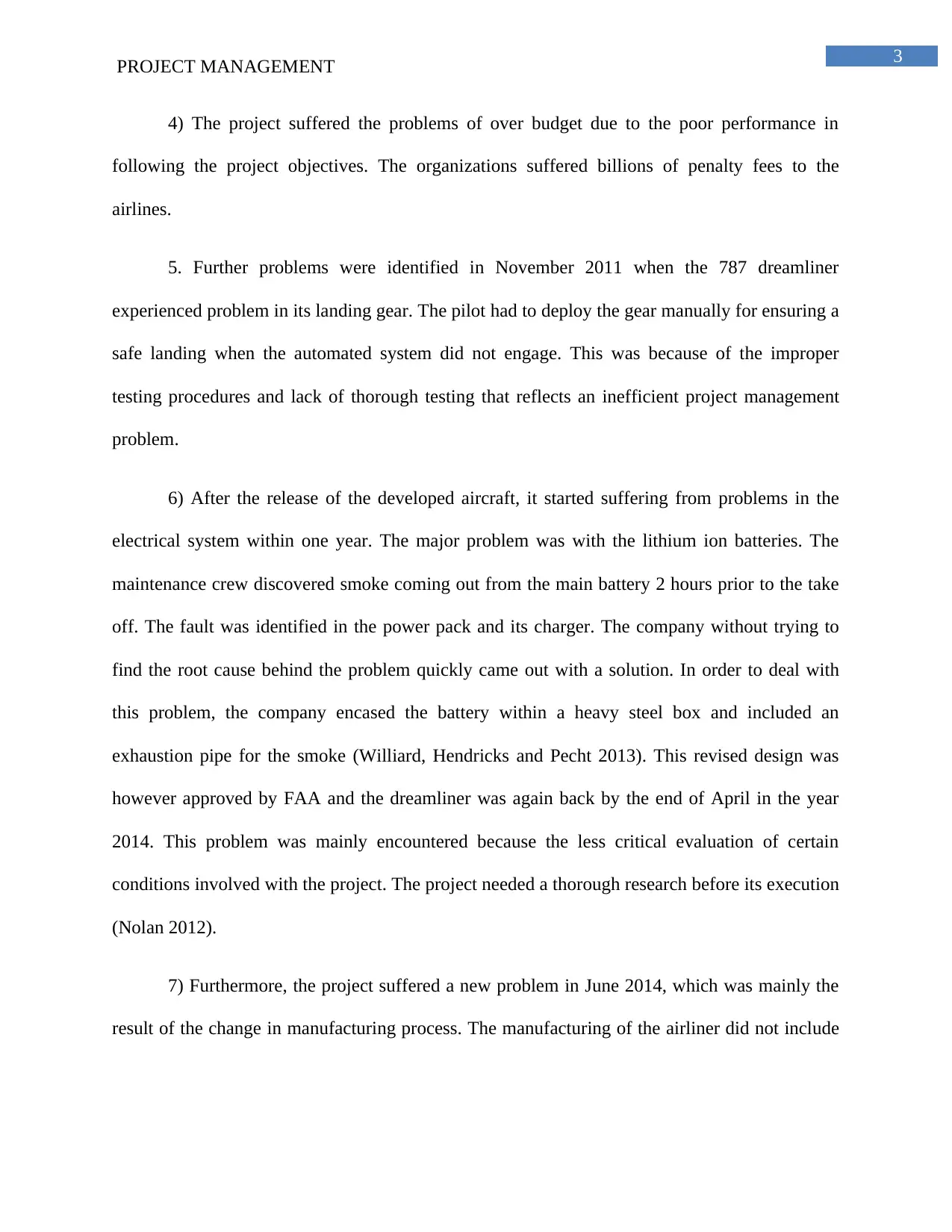
3
PROJECT MANAGEMENT
4) The project suffered the problems of over budget due to the poor performance in
following the project objectives. The organizations suffered billions of penalty fees to the
airlines.
5. Further problems were identified in November 2011 when the 787 dreamliner
experienced problem in its landing gear. The pilot had to deploy the gear manually for ensuring a
safe landing when the automated system did not engage. This was because of the improper
testing procedures and lack of thorough testing that reflects an inefficient project management
problem.
6) After the release of the developed aircraft, it started suffering from problems in the
electrical system within one year. The major problem was with the lithium ion batteries. The
maintenance crew discovered smoke coming out from the main battery 2 hours prior to the take
off. The fault was identified in the power pack and its charger. The company without trying to
find the root cause behind the problem quickly came out with a solution. In order to deal with
this problem, the company encased the battery within a heavy steel box and included an
exhaustion pipe for the smoke (Williard, Hendricks and Pecht 2013). This revised design was
however approved by FAA and the dreamliner was again back by the end of April in the year
2014. This problem was mainly encountered because the less critical evaluation of certain
conditions involved with the project. The project needed a thorough research before its execution
(Nolan 2012).
7) Furthermore, the project suffered a new problem in June 2014, which was mainly the
result of the change in manufacturing process. The manufacturing of the airliner did not include
PROJECT MANAGEMENT
4) The project suffered the problems of over budget due to the poor performance in
following the project objectives. The organizations suffered billions of penalty fees to the
airlines.
5. Further problems were identified in November 2011 when the 787 dreamliner
experienced problem in its landing gear. The pilot had to deploy the gear manually for ensuring a
safe landing when the automated system did not engage. This was because of the improper
testing procedures and lack of thorough testing that reflects an inefficient project management
problem.
6) After the release of the developed aircraft, it started suffering from problems in the
electrical system within one year. The major problem was with the lithium ion batteries. The
maintenance crew discovered smoke coming out from the main battery 2 hours prior to the take
off. The fault was identified in the power pack and its charger. The company without trying to
find the root cause behind the problem quickly came out with a solution. In order to deal with
this problem, the company encased the battery within a heavy steel box and included an
exhaustion pipe for the smoke (Williard, Hendricks and Pecht 2013). This revised design was
however approved by FAA and the dreamliner was again back by the end of April in the year
2014. This problem was mainly encountered because the less critical evaluation of certain
conditions involved with the project. The project needed a thorough research before its execution
(Nolan 2012).
7) Furthermore, the project suffered a new problem in June 2014, which was mainly the
result of the change in manufacturing process. The manufacturing of the airliner did not include
Paraphrase This Document
Need a fresh take? Get an instant paraphrase of this document with our AI Paraphraser
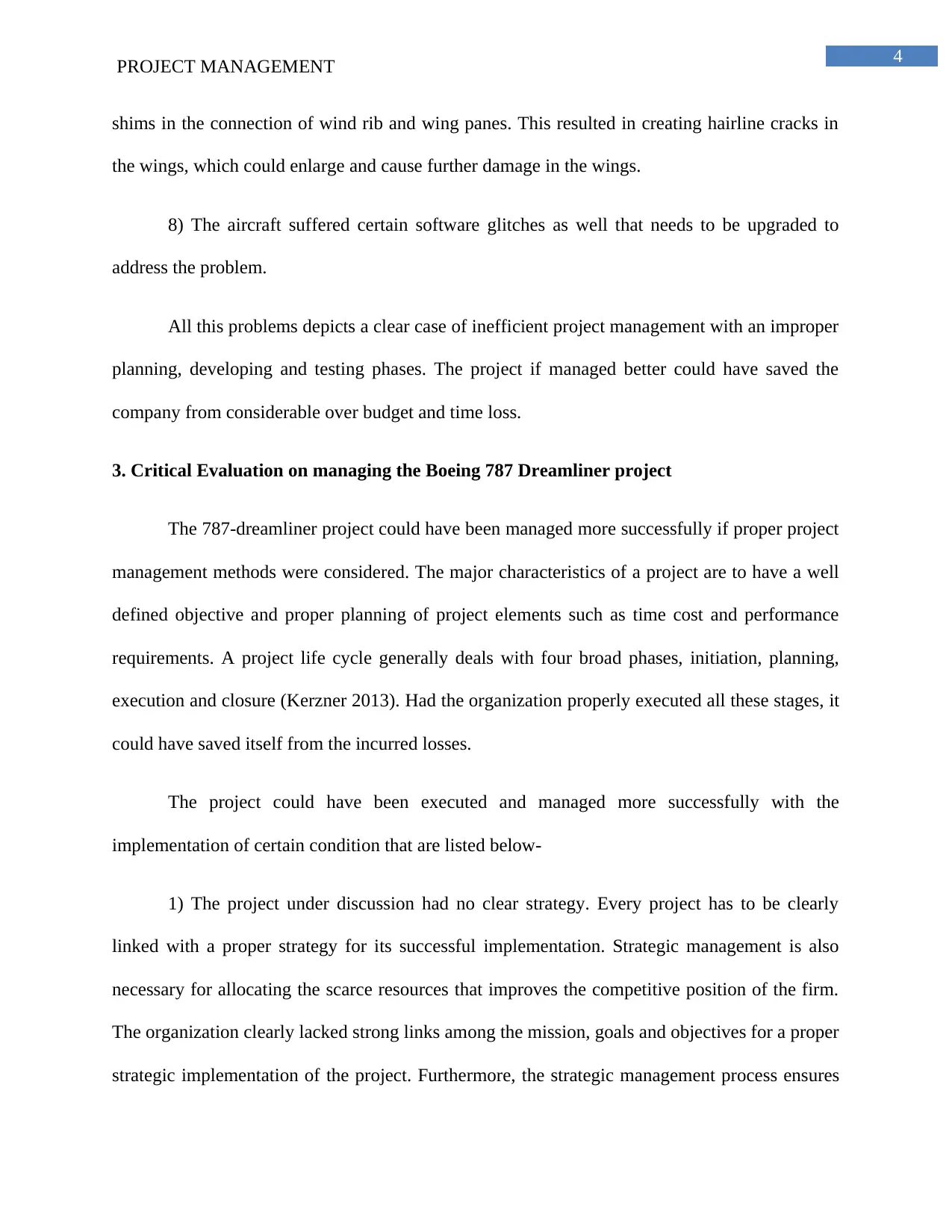
4
PROJECT MANAGEMENT
shims in the connection of wind rib and wing panes. This resulted in creating hairline cracks in
the wings, which could enlarge and cause further damage in the wings.
8) The aircraft suffered certain software glitches as well that needs to be upgraded to
address the problem.
All this problems depicts a clear case of inefficient project management with an improper
planning, developing and testing phases. The project if managed better could have saved the
company from considerable over budget and time loss.
3. Critical Evaluation on managing the Boeing 787 Dreamliner project
The 787-dreamliner project could have been managed more successfully if proper project
management methods were considered. The major characteristics of a project are to have a well
defined objective and proper planning of project elements such as time cost and performance
requirements. A project life cycle generally deals with four broad phases, initiation, planning,
execution and closure (Kerzner 2013). Had the organization properly executed all these stages, it
could have saved itself from the incurred losses.
The project could have been executed and managed more successfully with the
implementation of certain condition that are listed below-
1) The project under discussion had no clear strategy. Every project has to be clearly
linked with a proper strategy for its successful implementation. Strategic management is also
necessary for allocating the scarce resources that improves the competitive position of the firm.
The organization clearly lacked strong links among the mission, goals and objectives for a proper
strategic implementation of the project. Furthermore, the strategic management process ensures
PROJECT MANAGEMENT
shims in the connection of wind rib and wing panes. This resulted in creating hairline cracks in
the wings, which could enlarge and cause further damage in the wings.
8) The aircraft suffered certain software glitches as well that needs to be upgraded to
address the problem.
All this problems depicts a clear case of inefficient project management with an improper
planning, developing and testing phases. The project if managed better could have saved the
company from considerable over budget and time loss.
3. Critical Evaluation on managing the Boeing 787 Dreamliner project
The 787-dreamliner project could have been managed more successfully if proper project
management methods were considered. The major characteristics of a project are to have a well
defined objective and proper planning of project elements such as time cost and performance
requirements. A project life cycle generally deals with four broad phases, initiation, planning,
execution and closure (Kerzner 2013). Had the organization properly executed all these stages, it
could have saved itself from the incurred losses.
The project could have been executed and managed more successfully with the
implementation of certain condition that are listed below-
1) The project under discussion had no clear strategy. Every project has to be clearly
linked with a proper strategy for its successful implementation. Strategic management is also
necessary for allocating the scarce resources that improves the competitive position of the firm.
The organization clearly lacked strong links among the mission, goals and objectives for a proper
strategic implementation of the project. Furthermore, the strategic management process ensures
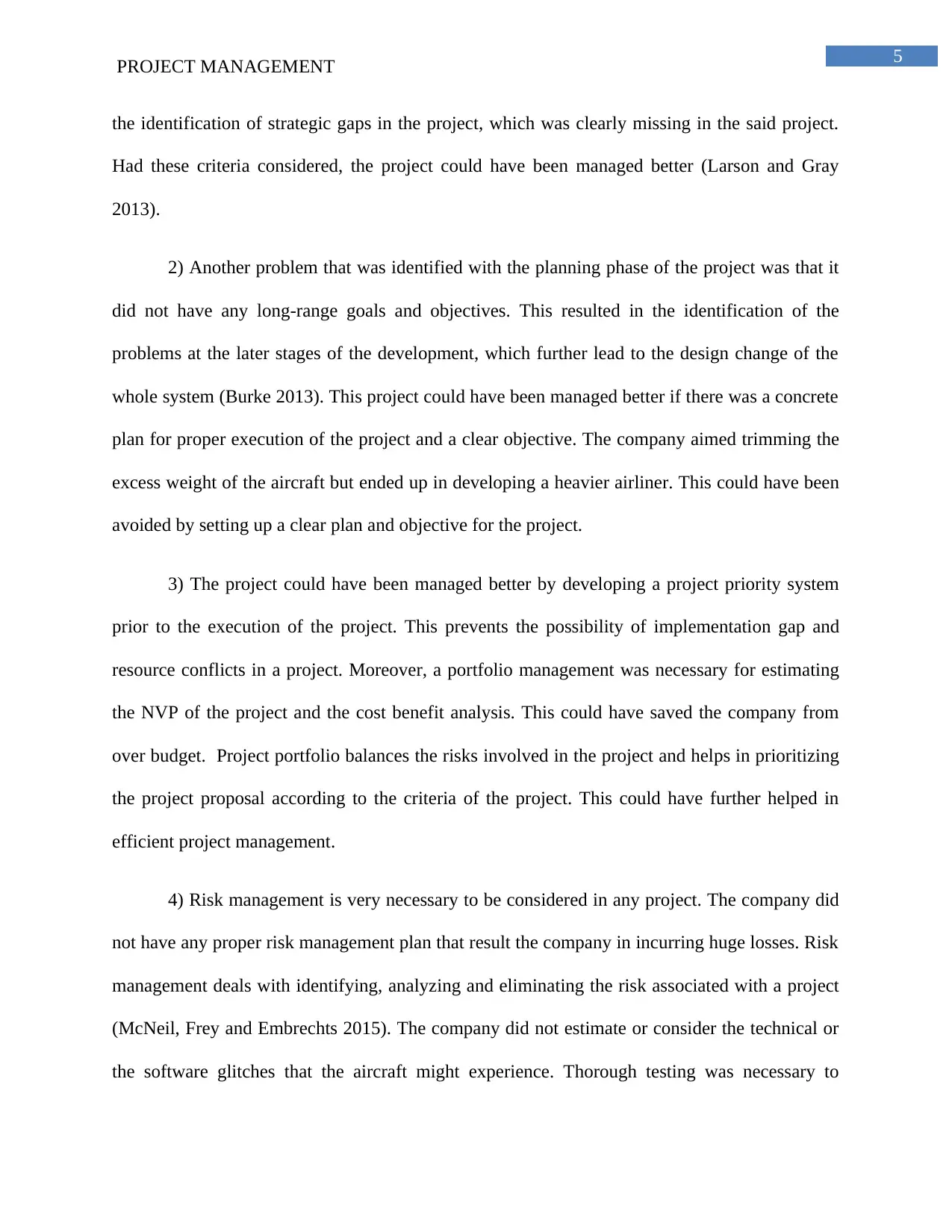
5
PROJECT MANAGEMENT
the identification of strategic gaps in the project, which was clearly missing in the said project.
Had these criteria considered, the project could have been managed better (Larson and Gray
2013).
2) Another problem that was identified with the planning phase of the project was that it
did not have any long-range goals and objectives. This resulted in the identification of the
problems at the later stages of the development, which further lead to the design change of the
whole system (Burke 2013). This project could have been managed better if there was a concrete
plan for proper execution of the project and a clear objective. The company aimed trimming the
excess weight of the aircraft but ended up in developing a heavier airliner. This could have been
avoided by setting up a clear plan and objective for the project.
3) The project could have been managed better by developing a project priority system
prior to the execution of the project. This prevents the possibility of implementation gap and
resource conflicts in a project. Moreover, a portfolio management was necessary for estimating
the NVP of the project and the cost benefit analysis. This could have saved the company from
over budget. Project portfolio balances the risks involved in the project and helps in prioritizing
the project proposal according to the criteria of the project. This could have further helped in
efficient project management.
4) Risk management is very necessary to be considered in any project. The company did
not have any proper risk management plan that result the company in incurring huge losses. Risk
management deals with identifying, analyzing and eliminating the risk associated with a project
(McNeil, Frey and Embrechts 2015). The company did not estimate or consider the technical or
the software glitches that the aircraft might experience. Thorough testing was necessary to
PROJECT MANAGEMENT
the identification of strategic gaps in the project, which was clearly missing in the said project.
Had these criteria considered, the project could have been managed better (Larson and Gray
2013).
2) Another problem that was identified with the planning phase of the project was that it
did not have any long-range goals and objectives. This resulted in the identification of the
problems at the later stages of the development, which further lead to the design change of the
whole system (Burke 2013). This project could have been managed better if there was a concrete
plan for proper execution of the project and a clear objective. The company aimed trimming the
excess weight of the aircraft but ended up in developing a heavier airliner. This could have been
avoided by setting up a clear plan and objective for the project.
3) The project could have been managed better by developing a project priority system
prior to the execution of the project. This prevents the possibility of implementation gap and
resource conflicts in a project. Moreover, a portfolio management was necessary for estimating
the NVP of the project and the cost benefit analysis. This could have saved the company from
over budget. Project portfolio balances the risks involved in the project and helps in prioritizing
the project proposal according to the criteria of the project. This could have further helped in
efficient project management.
4) Risk management is very necessary to be considered in any project. The company did
not have any proper risk management plan that result the company in incurring huge losses. Risk
management deals with identifying, analyzing and eliminating the risk associated with a project
(McNeil, Frey and Embrechts 2015). The company did not estimate or consider the technical or
the software glitches that the aircraft might experience. Thorough testing was necessary to
⊘ This is a preview!⊘
Do you want full access?
Subscribe today to unlock all pages.

Trusted by 1+ million students worldwide
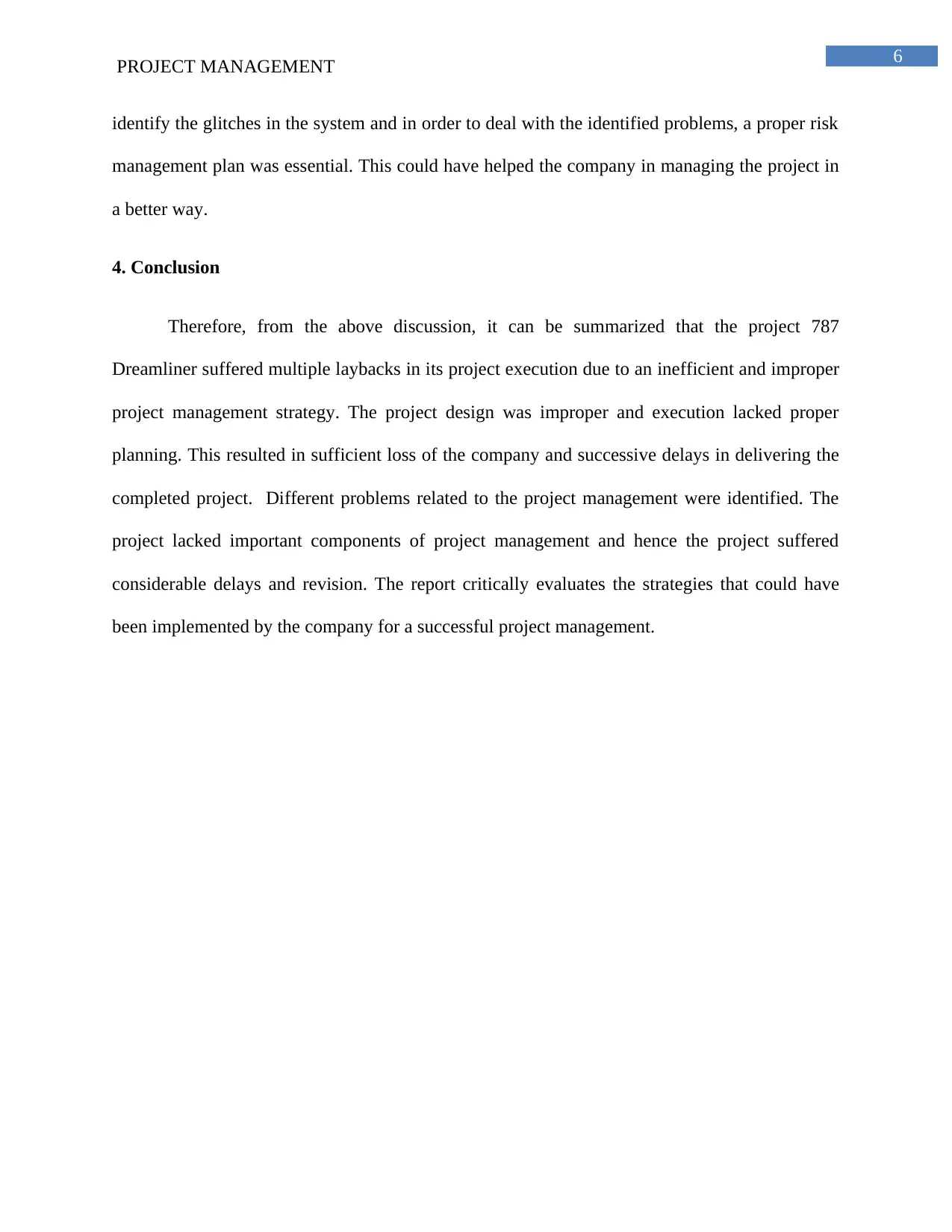
6
PROJECT MANAGEMENT
identify the glitches in the system and in order to deal with the identified problems, a proper risk
management plan was essential. This could have helped the company in managing the project in
a better way.
4. Conclusion
Therefore, from the above discussion, it can be summarized that the project 787
Dreamliner suffered multiple laybacks in its project execution due to an inefficient and improper
project management strategy. The project design was improper and execution lacked proper
planning. This resulted in sufficient loss of the company and successive delays in delivering the
completed project. Different problems related to the project management were identified. The
project lacked important components of project management and hence the project suffered
considerable delays and revision. The report critically evaluates the strategies that could have
been implemented by the company for a successful project management.
PROJECT MANAGEMENT
identify the glitches in the system and in order to deal with the identified problems, a proper risk
management plan was essential. This could have helped the company in managing the project in
a better way.
4. Conclusion
Therefore, from the above discussion, it can be summarized that the project 787
Dreamliner suffered multiple laybacks in its project execution due to an inefficient and improper
project management strategy. The project design was improper and execution lacked proper
planning. This resulted in sufficient loss of the company and successive delays in delivering the
completed project. Different problems related to the project management were identified. The
project lacked important components of project management and hence the project suffered
considerable delays and revision. The report critically evaluates the strategies that could have
been implemented by the company for a successful project management.
Paraphrase This Document
Need a fresh take? Get an instant paraphrase of this document with our AI Paraphraser
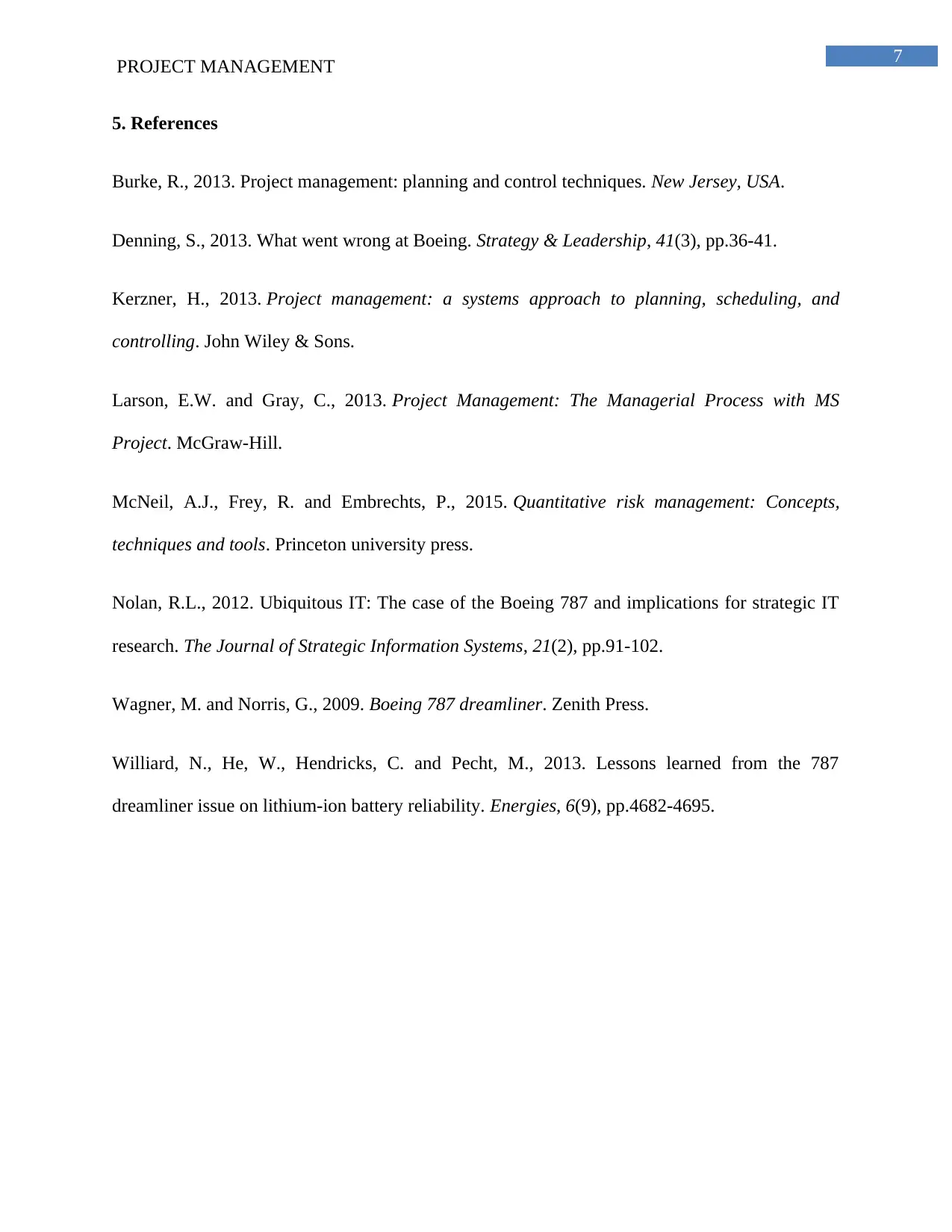
7
PROJECT MANAGEMENT
5. References
Burke, R., 2013. Project management: planning and control techniques. New Jersey, USA.
Denning, S., 2013. What went wrong at Boeing. Strategy & Leadership, 41(3), pp.36-41.
Kerzner, H., 2013. Project management: a systems approach to planning, scheduling, and
controlling. John Wiley & Sons.
Larson, E.W. and Gray, C., 2013. Project Management: The Managerial Process with MS
Project. McGraw-Hill.
McNeil, A.J., Frey, R. and Embrechts, P., 2015. Quantitative risk management: Concepts,
techniques and tools. Princeton university press.
Nolan, R.L., 2012. Ubiquitous IT: The case of the Boeing 787 and implications for strategic IT
research. The Journal of Strategic Information Systems, 21(2), pp.91-102.
Wagner, M. and Norris, G., 2009. Boeing 787 dreamliner. Zenith Press.
Williard, N., He, W., Hendricks, C. and Pecht, M., 2013. Lessons learned from the 787
dreamliner issue on lithium-ion battery reliability. Energies, 6(9), pp.4682-4695.
PROJECT MANAGEMENT
5. References
Burke, R., 2013. Project management: planning and control techniques. New Jersey, USA.
Denning, S., 2013. What went wrong at Boeing. Strategy & Leadership, 41(3), pp.36-41.
Kerzner, H., 2013. Project management: a systems approach to planning, scheduling, and
controlling. John Wiley & Sons.
Larson, E.W. and Gray, C., 2013. Project Management: The Managerial Process with MS
Project. McGraw-Hill.
McNeil, A.J., Frey, R. and Embrechts, P., 2015. Quantitative risk management: Concepts,
techniques and tools. Princeton university press.
Nolan, R.L., 2012. Ubiquitous IT: The case of the Boeing 787 and implications for strategic IT
research. The Journal of Strategic Information Systems, 21(2), pp.91-102.
Wagner, M. and Norris, G., 2009. Boeing 787 dreamliner. Zenith Press.
Williard, N., He, W., Hendricks, C. and Pecht, M., 2013. Lessons learned from the 787
dreamliner issue on lithium-ion battery reliability. Energies, 6(9), pp.4682-4695.
1 out of 8
Related Documents
Your All-in-One AI-Powered Toolkit for Academic Success.
+13062052269
info@desklib.com
Available 24*7 on WhatsApp / Email
![[object Object]](/_next/static/media/star-bottom.7253800d.svg)
Unlock your academic potential
Copyright © 2020–2025 A2Z Services. All Rights Reserved. Developed and managed by ZUCOL.





